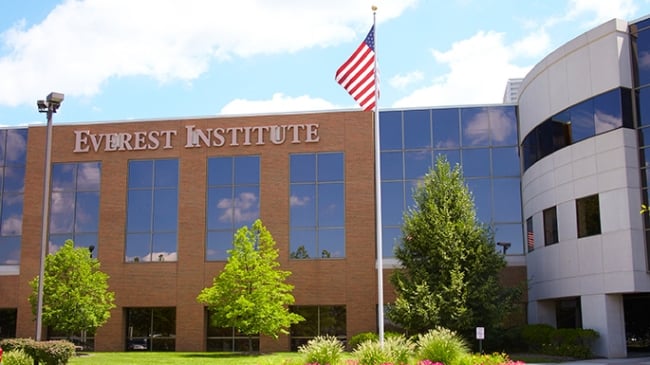You have /5 articles left.
Sign up for a free account or log in.

Everest Institute campus located near Columbus, Ohio
Everest
Zenith Education Group, which 18 months ago bought more than half of Corinthian Colleges’ campuses, has a new leader and a new $250 million endowment.
ECMC Group, the large student loan guaranty agency, spent $24 million for 53 WyoTech and Everest campuses, as well as Corinthian’s online programs. Zenith, a nonprofit, enrolled 33,000 students after the purchase.
Since then the career college chain has hemorrhaged students and money, continuing Corinthian’s struggles, minus the raft of state or federal investigations the controversial for-profit faced.
Zenith lost $100 million last year. It now enrolls 10,000 students at 24 campuses, having consolidated, closed or begun teaching out the remaining campuses. The cuts have been painful, including layoffs of more than half of its workforce. Zenith now employs 2,600 faculty and staff members.
Yet ECMC isn’t giving up without a fight.
The guaranty agency today announced that its governing board will give $250 million to the ECMC Foundation to support Zenith. The foundation’s current president, Peter Taylor, will become Zenith’s president and CEO. He replaces Dave Hawn, ECMC Group’s president and CEO, who also has been Zenith’s interim leader since its creation in February 2015. Hawn will continue to run ECMC.
Taylor and Hawn were optimistic in a phone interview this week. Essentially starting over again with Corinthian’s “heavily distressed” programs hasn’t been easy. But the mostly blank slate comes with advantages, they said.
Rebuilding the academic programs at Zenith’s 24 campuses is a “rare legacy opportunity for all of us,” said Taylor. The chain plans to continue drawing lessons from community colleges and other nonprofits to look for a “third pathway,” he said, meaning a “new way to do student-centered career education.”
That includes a more hands-on approach than many public community colleges can provide, with more resources and student supports, Taylor said, but without the sometimes perverse incentives of many for-profits.
Zenith’s sale included a deal to forgive $480 million of debt held by former Corinthian students. The nonprofit also has cut its tuition, bulked up curricula and focused on helping students land well-paying jobs.
However, consumer and student advocates have been critical of Zenith, arguing the nonprofit has not done enough to change its former Corinthian holdings (more on that debate later). One criticism is that the chain had not brought in new leadership with higher education chops.
Taylor recently worked for the University of California System, where he was executive vice president and chief financial officer. During his five-year stint at UC, which ended in 2014, Taylor was credited with helping the 10-campus system weather California’s severe financial crisis, through cost cutting with joint purchasing and by boosting investment returns.
An expert on government bonds and financing, Taylor previously worked at Lehman Brothers and Barclays Capital. He also is a member of the California State University System’s Board of Trustees. Asked about potential conflicts in that role, Taylor said Zenith focuses on nontraditional students (unlike Cal State) and does not operate campuses in California.
Taylor will join Mary Ostrye, Zenith’s provost and chief academic officer, who arrived last August. Ostrye also has a background in traditional higher education, having most recently been provost and senior vice president for Ivy Tech Community College, which is Indiana’s statewide two-year chain.
Zenith’s new $250 million endowment is both a fiscal boost and a statement that ECMC is serious about making Everest and WyoTech’s remaining programs viable, said Taylor and Hawn.
“We didn’t embark on this journey for the short haul,” Hawn said. “We want to make a difference in career education in America.”
If they fail, however, one outcome could be what some Corinthian critics called for when the for-profit first collapsed.
Ben Miller, senior director for postsecondary education at the Center for American Progress and a former official at the U.S. Education Department, said Zenith’s leaders, for the most part, seem to mean well with their plans for the chain.
Yet “intentions are brushing up against a business model,” he said, adding that Zenith is trying to fix a deeply flawed infrastructure in midstream, while still recruiting students and issuing credentials.
Miller said he’s skeptical that approach can work. And if Zenith goes bust, the result would be a “semiorderly wind down of Corinthian,” he said, “which should have happened in the first place.”
Training Medical Assistants
Taylor oversaw UC’s $9 billion endowment. He described Zenith’s new money as a “fund functioning as an endowment,” a financial term for a quasi endowment that lacks many of the spending restrictions on a traditional endowment fund.
“They’re giving us a great deal of flexibility to spend as needed,” he said.
Zenith will draw down the standard amount of roughly 5 percent of the fund per year, Taylor said, using that $13 million or so to support “transformational opportunities” to improve student success.
In addition, he said the fund’s structure includes the advantage of being able to dip into the principal to back a “great idea,” meaning Zenith could spend more than 5 percent of the endowment in a year.
The career college chain already has made substantial changes. On the academic side, one of its focuses has been improving programs that train medical assistants.
“We decided to look at where we could impact the most students,” said Ostrye.
Zenith first used its approach to curriculum redesign with medical assistant training. Faculty members led the work, which included a survey of employers to understand their preferred skills and certifications.
Instructors decided to embed nationally recognized certifications in the programs, Ostrye said, making them required for students. “That’s a radical change,” she said.
Roughly 60 percent of Corinthian’s business was in medical assistant programs, said Trace Urdan, a senior analyst for Credit Suisse, who is an expert on for-profits. And he said enrollment is down nationwide at most institutions that train medical assistants.
“The kind of programs that they offer are out of favor everywhere,” Urdan said.
The jobs are there, he said, and employers are desperate for medical assistants. But the students just aren’t showing up, according to Urdan. The problem for Zenith is that the enrollment slide is a “cyclical dimension that’s outside of their control.”
Zenith’s leaders hope the improved quality of their medical assistant programs will be a draw for students and employers alike. The new pathways are “stackable,” meaning medical-assistant program graduates should be able to retain credits as they pursue more credentials in health care.
Information technology and other programs will follow suit, said Ostrye, with curriculum overhauls and stackable credentials.
Roughly 80 percent of Zenith’s campus-based academic tracks are short term, Hawn said, with nine to 10 months of programming. And he said demand for many of those credentials has remained “tepid” during the economy’s recovery.
“It’s still a tough market,” he said. “However, the allied health field is still growing.”
Pauline Abernathy has not been impressed by Zenith. Abernathy, who is executive vice president of the Institute for College Access & Success, said the chain’s March progress report showed too much of Corinthian’s roots, including a paid governing board, enrollment agreements students must sign and mostly unchanged curricula.
“ECMC’s stated goal was to change the Corinthian schools,” she said. “But its March report indicated that much was exactly the same.”
Just as important, Abernathy questioned the continued existence of Everest and WyoTech.
“What is the need that they’re meeting?” she said.
Taylor and Hawn said Zenith’s goal is to reinvent career education, which Hawn has said is a broken sector, but one that prepares many people to serve in vital roles, including medical assistants.
The key, they said, is to build enrollments while staying focused on strong student results, obviously avoiding the sort of fraudulent overpromising that led to Corinthian’s demise -- and the defrauding of tens of thousands of students.
One way Zenith has begun that process is by ending its national advertising for Everest and shifting marketing money to local campuses, which can be more targeted with ads.
“It doesn’t help us to enroll students who are not going to benefit from our academic programming,” said Hawn.
Once students enroll, Zenith has tried to reduce the debt they take on, by last year awarding more than $100 million in tuition reductions and scholarships while also spending money on initiatives aimed at student completion and job placement. So far Zenith has reduced its overall student debt burden by 20 percent.
As for when the chain will hit the bottom of its enrollment and revenue slide, Hawn said Zenith may be in position to start growing its remaining campuses.
“We believe we’re really where we want to be,” he said. “We’re just getting warmed up.”








